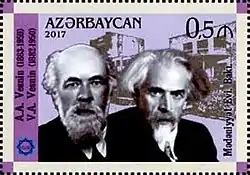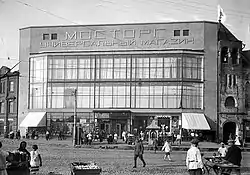Viktor Vesnin
Viktor Aleksandrovich Vesnin (Russian: Виктор Александрович Веснин; April 9, 1882 – September 17, 1950), was a Russian Empire and Soviet architect. His early works (1909–1915) follow the canon of Neoclassicist Revival; in the 1920s, he and his brothers Leonid (1880–1933) and Alexander (1883–1959) emerged as leaders of Constructivist architecture, the Vesnin brothers. After the crackdown on Constructivism in 1931-32 and until his death, Viktor Vesnin was the highest-ranked architect in Soviet system, heading the Union of Soviet Architects and Academy of Architecture. As a lead architect for heavy construction, he supervised many industrial projects, but his own visionary drafts of this period never materialized.[1][2]
Viktor Vesnin | |
|---|---|
 | |
| Born | Viktor Aleksandrovich Vesnin April 9, 1882 |
| Died | September 17, 1950 |
| Nationality | Russian |
| Occupation | Architect |
| Practice | Vesnin Brothers, NKTP Architectural Board |
| Buildings | DnieproGES |
| Projects | Palace of Soviets, NKTP Building on Red Square |
Selected work

Stamps of Azerbaijan, 2017

Mostorg department store, 1928
- 1934 People's Commissariat of Heavy Industry Project
- 1927-1932 DnieproGES, with Nikolai Kolli
- 1930 Palace of Culture of the Proletarsky district, Moscow
- 1928 House of Film Actors, Moscow
- 1926 Mostorg department store, Moscow
- 1924 Leningradskaya Pravda project
- 1922-23 Palace of Labor project
- 1915 Sirotkin House, Nizhny Novgorod
- 1914 Mantashev Stables, Moscow Racetrack (with A.G.Izmirov, Alexander Vesnin) [3]
References
- Viktor Vesnin at archINFORM
- www.utopia.ru
- Russian:Памятники архитектуры Москвы, Окрестности старой Москвы, М., 2004, cтр.133, ISBN 5-98051-011-7
External links
This article is issued from Wikipedia. The text is licensed under Creative Commons - Attribution - Sharealike. Additional terms may apply for the media files.